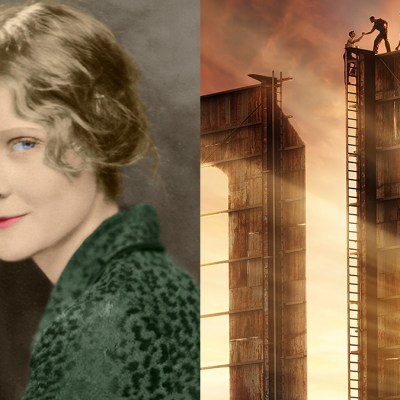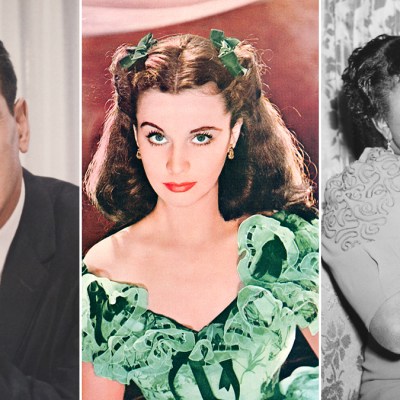Netflix’s Hollywood and The Real History of Vivien Leigh
For years, icon Vivien Leigh was branded a nymphomaniac, as somewhat joked about in Netflix’s Hollywood, but she really opened a window into the broken psyche.

This article contains mild Hollywood spoilers.
On Netflix’s new series Hollywood, the Stallions of the Gas Station, circa 1947, fill up a dinner party being thrown by legendary filmmaker George Cukor. In between bites, and biting remarks by the ever-incisive Tallulah Bankhead, we are treated to Vivien Leigh, played by Katie McGuinness, giving an impromptu reading of her captivating and iconic Scarlett O’Hara in Gone with the Wind (1939). At the after party, all of the celebrities entertain illicit passion for a predetermined price. Like his character on American Horror Story, Dylan McDermott’s fictional Ernie is renowned for a certain largesse, and he bestows his beneficence on Leigh, who also carries a secret.
Up until quite recently, Vivien Leigh, the legendary star of stage and screen, was branded with the label nymphomaniac, a derogatory-sounding term which makes it sound like she was a sex addict. In reality, she fought a lifelong battle with bipolar disorder during a time the illness wasn’t discussed. Her condition was believed to have been triggered by a devastating miscarriage in 1945, but evidence of the illness surfaced long before the incident and before any diagnosis would be then available.
Leigh is one of the best actresses of all-time. She had a near-photographic memory and knew her lines after one or two readings of a play. She was the first British woman to win an Academy Award for Best Actress, thanks again to Scarlett. Her relationship with Shakespearean acting icon Laurence Olivier was one of love and tragedy, which could have been written by the Bard himself. Before Brangelina, Liz and Dick, or even Bogie and Bacall, their match was mythological, even by Hollywood standards.
Olivier was married to actress Jill Esmond when they first met in 1936. Leigh had given a performance on the London stage. Their affair began a year later while co-starring in the British film, Fire Over England. They married in 1940 (after shaking off each’s own ex-spouse), and the couple performed together in a lavish Broadway production of Romeo and Juliet, as well as Anthony and Cleopatra on the West End. On screen they finally collaborated in That Hamilton Woman (1941), a British film so hot in its sizzle and pro-English sentiment that Winston Churchill made the couple drinking buddies and sent a print to FDR as proper propaganda.
When Olivier was cast as Heathcliff in 1939’s Wuthering Heights, Leigh campaigned to play Cathy. It would have been her Hollywood debut. Director William Wyler said she could play the role of Isabella. She turned it down flatly, and wound up making her American debut elsewhere.
Leigh beat out hundreds of actresses, including top stars like Bette Davis, Katharine Hepburn, Paulette Goddard, and Joan Crawford, to be cast in Gone with the Wind. Clark Gable, who played lovable scoundrel Rhett Butler, was paid $120,000 for 71 days of shooting. She was so good in the finished film even Southern critics, offended that an English woman living with a man who wasn’t her husband, were won over. Leigh was paid $25,000 for 125 days of work, filming 16 hours a day, six days a week. Because of the extreme stress, Leigh took an overdose of sleeping pills during the production. Studies have shown lack of sleep is a common side effect of depression, and stress plays a major role in triggering manic bipolar phases.
Most historians trace her mental illness to a miscarriage Leigh suffered during the filming of the Gabriel Pascal epic, Caesar and Cleopatra, which came out in 1945. The actress, who was pregnant with Olivier’s child, slipped and fell while running across a polished floor for a scene. The resulting trauma of the loss led to what has been reported to be her first mental breakdown.
Leigh swung from crippling depression to hyperactive phases of mania, causing her to stay up all night long. But gossip about Leigh’s condition first surfaced when she played Ophelia to Olivier’s titular Hamlet in an Old Vic Theatre production in 1937. Ophelia is one of the best known mad woman characters in the history of acted entertainment, yet Olivier was aghast when he told cast members his then-girlfriend had gone suddenly crazy in her dressing room, verbally lashing out at him without warning. The outburst ended as quickly as it began.
Leigh was born Vivian Mary Hartley in 1913 in Darjeeling, India. She knew she wanted to be an actress from the time she was three and recited “Little Bo Peep” for her mother’s theater group. With the benefit of hindsight, early indicators of her condition may have surfaced when she was sent to a convent school in London when she was six years old. She enrolled in London’s Royal Academy of Dramatic Arts when she was 18, and biographies have quoted classmates saying Leigh exhibited minor signs.
Bipolar disorder was called manic-depression during Leigh’s adult life, and it’s a long-term illness which has to be managed throughout a person’s life. Symptoms are severe and different from what might be written off as mood swings. The brain disorder often develops in the late teenage or early adult years and is not easy to spot because the symptoms often appear to be separate issues.
Leigh was under psychological strain trying to match Olivier’s reputation on the stage. They were paired in a production of Twelfth Night, directed by John Gielgud, and reviews paid more attention to Olivier than Leigh. While playing Lady Macbeth opposite her husband in the Stratford Festival’s production of Shakespeare’s Scottish play, she mirrored her character’s descent into madness. Director Anthony Quayle said Leigh “was feeding her own mania into the tragedy…. She was mesmerizing,” according to the book Vivien: The Life of Vivien Leigh by Alexander Walker. In 1944, one year before her miscarriage, Leigh suffered her first severe case of tuberculosis and took a year off. Olivier was knighted in 1947, and Vivien became Lady Olivier.
She won another Oscar in 1951 for another Southern belle role in A Streetcar Named Desire. Tennessee Williams’ character Blanche DuBois was a mirror image of the actress who played her. She was hypersexual, vulnerable, and prone to manic and depressive swings and outbursts of paranoia. Leigh played the role when it debuted in London’s West End in 1949 and appeared in 326 performances before being cast in Elia Kazan’s film adaptation opposite Marlon Brando, who originated the role of Stanley Kowalski on Broadway. Leigh identified with Blanche’s psychology until “playing her tipped me into madness,” according to the Walker’s Vivien: The Life of Vivien Leigh.
In 1953, during filming in Sri Lanka of what would have been Leigh’s next movie, Elephant Walk, the actress became erratic and paranoid on set. Her chronic insomnia got worse and she complained she was suffering hallucinations. The incidents were reported in autobiographies by Olivier, and co-stars David Niven and Stewart Granger. People with bipolar disorder may experience periods of psychosis, which is when someone can’t distinguish reality from what’s going on in their head. Elizabeth Taylor went on to take the part.
On the flight back to Los Angeles, Leigh tried to jump out of the plane. Back in Hollywood, she reportedly screamed lines from A Streetcar Named Desire and refused to come out of her dressing room. The actress was sedated and flown back to England. Olivier had her committed at the exclusive Fairdene-Netherne mental asylum in Coulsdon, Surrey. As there were few drugs for mental illness at the time, she was treated with electroconvulsive therapy, a brain stimulation procedure where small electric currents are passed through the brain. She spent three months at the psychiatric hospital. Leigh reportedly appeared on stage with visible burn marks from the electroshock paddles on her temples.
Blanch Dubois always relied on the kindness of strangers and found comfort in kisses, softly, on the lips, in the most casual of encounters. One symptom of Leigh’s disorder was increased libido, which led to several extramarital affairs. She had an affair with Australian actor Peter Finch and told the story to screenwriter Terence Rattigan, who used it as the basis of the film The V.I.P.s, which starred Richard Burton and Elizabeth Taylor.
Olivier spent many years struggling with Leigh’s illness, the infidelities it caused, and the growing irrational behavior which erupted out of it. In 1948, while on a down under tour for the Old Vic, Leigh lost her shoes and refused to go on stage during a performance in Christchurch, New Zealand. Olivier slapped Leigh across the face in front of the company. She hit him back. Laurence said the tour sparked the end of their marriage. According to Anthony Holden’s book Olivier, British playwright Noel Coward believed, “If Larry had turned sharply on Vivien years ago and given her a good clip in the chops, he would have been spared a mint of trouble.” Mental illness carries much less stigma now but was completely misunderstood then. In 1956, Leigh dropped out of a Coward production after she became pregnant. She suffered a second miscarriage, which prompted another depressive breakdown.
Toward the end of their marriage, Leigh beat Olivier across the face with a wet towel. He lost control and tossed her across the bedroom. She appeared in public the next day wearing a black eye patch. The Oliviers divorced in 1960, after 20 years of marriage. He married actress Joan Plowright. She continued to act on stage and won a Tony Award in 1963 for her role in the play Tovarich.
Leigh’s last performance was in director Stanley Kramer’s 1965 film, Ship of Fools. She lashed out at the other actors and allegedly hit co-star Lee Marvin with a shoe so hard the wound was visible on his face, according to Hugo Vickers’ book Vivien Leigh.
In 1967, Leigh had a recurrence of tuberculosis, which left her bedridden for weeks. She died in July of that year at age 53. Her body was cremated and scattered near her home in Blackboys, East Sussex. Her legacy, however, has never dwindled. She captured a raw and naked emotional energy, which endures on screen. While her own disorder may have given her a window into the madness of her characters, the bravery she showed while exposing those nerves continues to inspire arts and now sciences. The world knows more intimately about broken minds, and on a personal level while watching Leigh play them on screen. We also know more about the disorder itself because her history is an educational chapter in psychological knowledge. Which is more than can be said about Hollywood’s punchline of her.
Hollywood is now streaming on Netflix.


